How to pick your ingredients

To start, choose your ingredients, beginning with the chips. When selecting tortilla chips, opt for flat varieties. Both triangular and circular shapes work well, but steer clear of scooping chips. While they are great for dips, they don't stack properly for nachos and can trap ingredients, preventing even distribution. It's also important to choose tortilla chips with a good thickness. We used Xochitl salted chips, which are tasty but can be a bit too thin to support nachos effectively. Kirkland Signature organic tortilla chips are an excellent budget-friendly choice for building your nacho base. Additionally, ensure the chips are salted but not flavored, as flavored chips can limit your topping choices.
Next, pick your toppings. This is largely a matter of personal taste, but try to avoid overly wet toppings. For instance, chili and salsa are fantastic additions to nachos, but should be added only after cooking to prevent the entire dish from becoming soggy. If you're using beans, be sure to drain them before adding them to the chips. Similarly, fresh jalapeños cooked on nachos are preferable to jarred ones, though this ultimately depends on your taste preferences.
Feel free to add some seasoning to your nachos as well. We used ground epazote, but you can also opt for taco seasoning or any other spices that you enjoy.
A note on cheese

The type of cheese you choose can significantly impact your nachos. We suggest opting for shredded cheese instead of cheese sauce, as the latter tends to be moist and can result in soggy nachos. Additionally, if you have the time, consider shredding your own cheese rather than using pre-shredded options. Pre-shredded cheese often contains anti-caking agents that can hinder the cheese from melting together smoothly.
When it comes to cheese varieties, cheddar serves as an excellent base due to its strong flavor and good melting properties. You can also blend it with Monterey or pepper jack cheese for a bit of spice. If you prefer pre-shredded cheese, Mexican cheese blends are a great choice, offering a mix of different cheesy flavors that enhance your nachos.
What you need
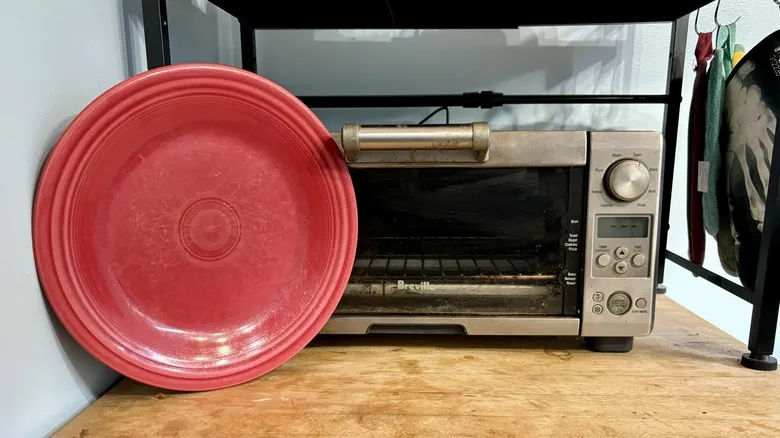
The necessary tools are quite straightforward: you'll need a heat-resistant plate or pan, an oven, and your favorite ingredients. If you're using a baking sheet, it can be beneficial to line it with parchment paper. Additionally, if your toppings require preparation, you might need forks, spoons, or knives for proper handling.
For our nachos, we utilized a Fiestaware plate, which is just the right size for one or two servings, and we cooked them in a toaster oven. This method is perfect for making smaller portions of nachos. We chose to top ours with freshly grated cheddar and jack cheese, drained olives, black beans, fresh jalapeños, and ground epazote. Ultimately, the choice of toppings is yours, but the preparation process remains the same.
Common mistakes people make cooking nachos
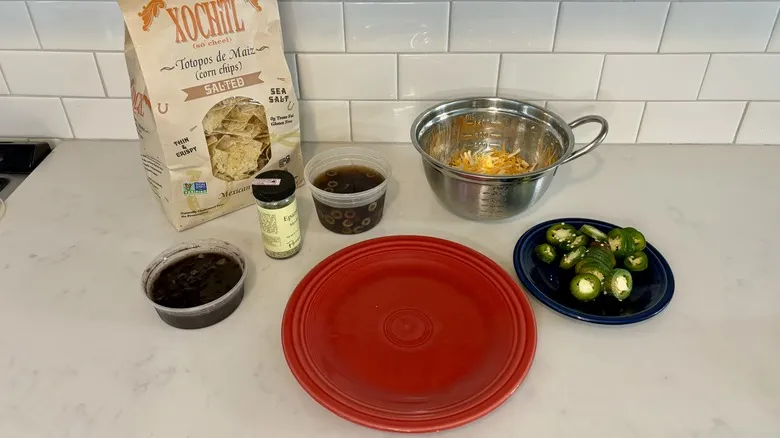
The most common errors people make when preparing nachos occur during the preparation stage. Avoid using a microwave to heat your nachos. While it may seem like a convenient shortcut, the outcome will be rubbery and chewy nachos that are far from enjoyable. The additional few minutes required to bake them is definitely worth it. Furthermore, refrain from piling your nachos too high. If they are stacked excessively, the heat won’t adequately melt the cheese in the center, leaving you with an unappetizing, cold core. It’s better to spread them out rather than stack them up.
Lastly, ensure that your toppings are cut into small pieces that can fit in a single bite. Nachos can be messy, but they shouldn’t be hard to eat. If you’re incorporating cooked chicken or peppers, make sure they are chopped small enough to create the perfect bite-sized nacho.
Preheat the oven
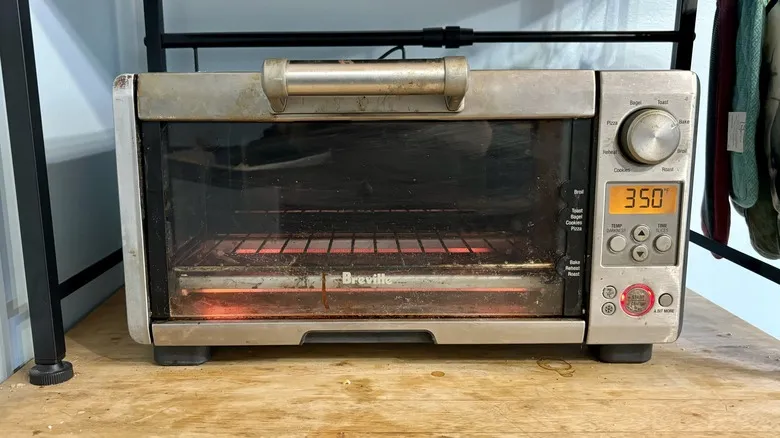
Preheat your oven to 350°F. You can use either a full-sized oven or a smaller toaster oven. We advise against using an air fryer due to the potential for mess.
Assemble your first layer of chips
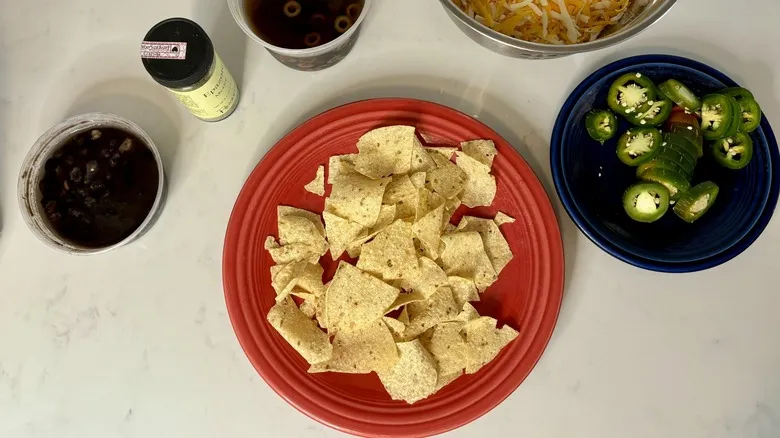
Spread a single layer of chips on the plate. It's acceptable for them to overlap slightly, but as mentioned, we want the nachos to expand outward rather than stack up. This approach will ensure more uniform cooking and improved distribution of toppings. Also, aim for whole chips instead of crumbled or broken pieces.
Optional: Add your seasoning
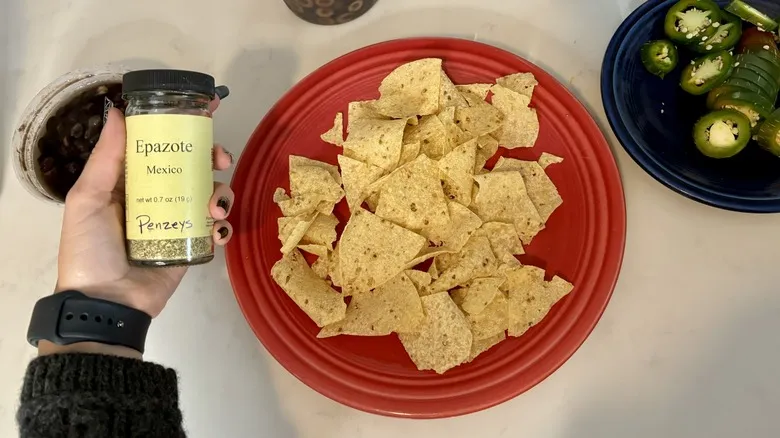
If you're adding a seasoning, now is the moment to sprinkle it over the chips. We opted for ground epazote, which, although not conventional, is quite tasty.
It's time for cheese
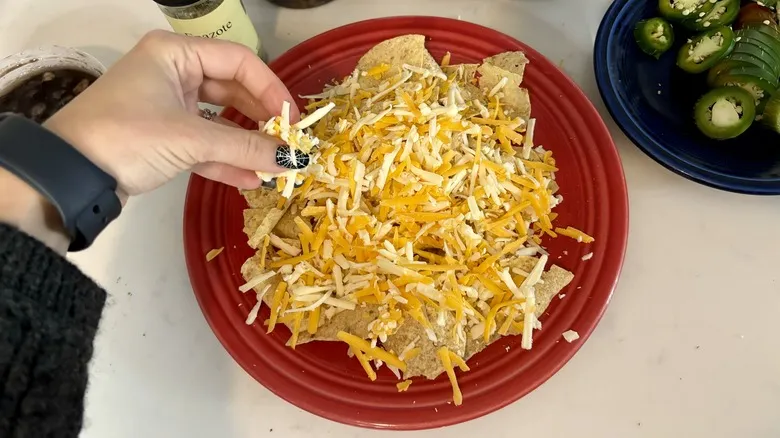
Evenly distribute your grated or shredded cheese over the nachos. Aim for a layer that is substantial enough to cover the chips without completely obscuring them. Using too much cheese can make the nachos heavy and cause excess oil to seep out, resulting in sogginess. The purpose of adding cheese at this stage is that, as it melts, it serves as a binding agent for your toppings, keeping them securely on the nachos.
Top it all off
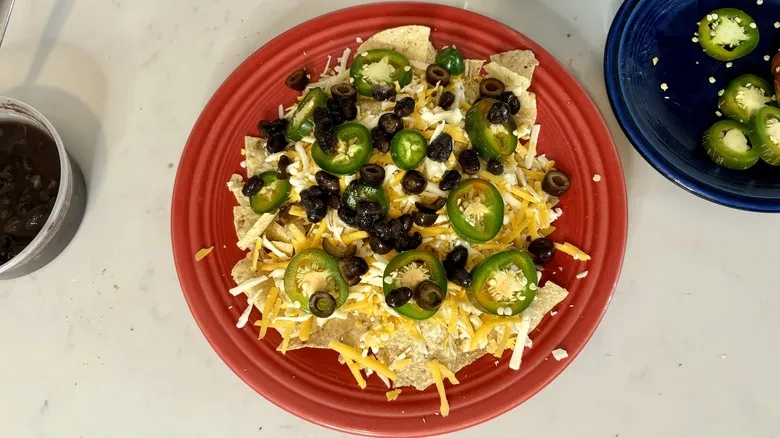
It's time to add your toppings! Feel free to include any bakeable options like meats, beans, tomatoes, peppers, or anything else you enjoy. At this point, please avoid adding wet or cold toppings like sour cream, salsa, chili, or guacamole, as these should be added after cooking.
Add your second layer of chips
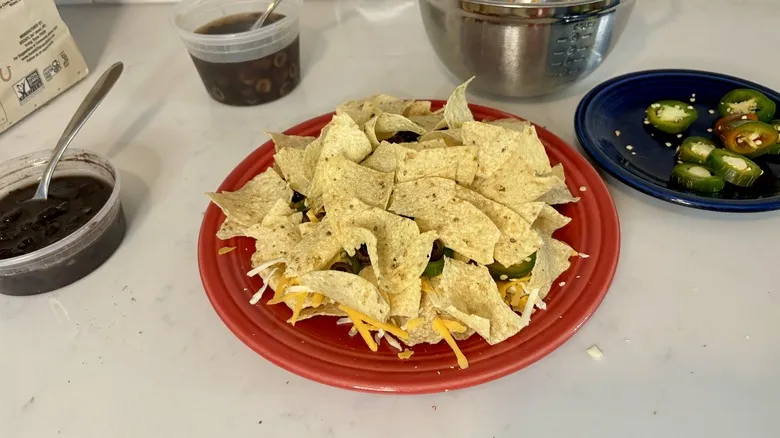
If you're craving more nachos, you can go for a second round! Simply follow the same steps again, beginning with another layer of chips. We advise against adding more than two layers to ensure that all the nachos are properly cooked and the cheese melts thoroughly.
Cook it up
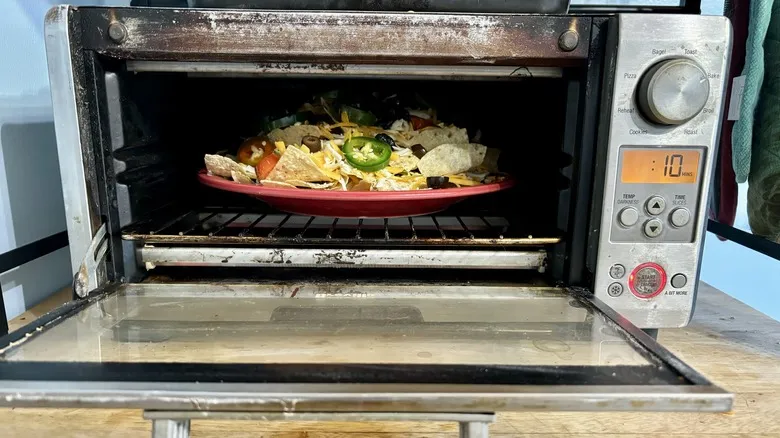
Put your nachos in the oven that has been preheated to 350°F. Bake for 10 minutes. This should allow the cheese to melt and give the chips and cheese edges a light golden brown color. If you prefer them a bit crispier or more melted, you can add an extra minute or two to the cooking time, but be sure to watch them closely to avoid overcooking or burning.
Add your garnish
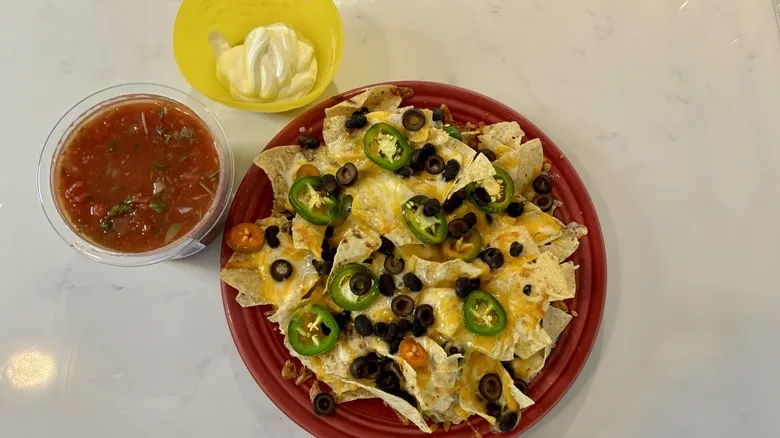
Finish it off with the chilled and moist ingredients like salsa, sour cream, and guacamole, or set them aside if you’d rather. This is the moment to add those finishing touches to create your ideal game day nachos, so feel free to be generous with the extras before serving.
Nacho varieties and recipes
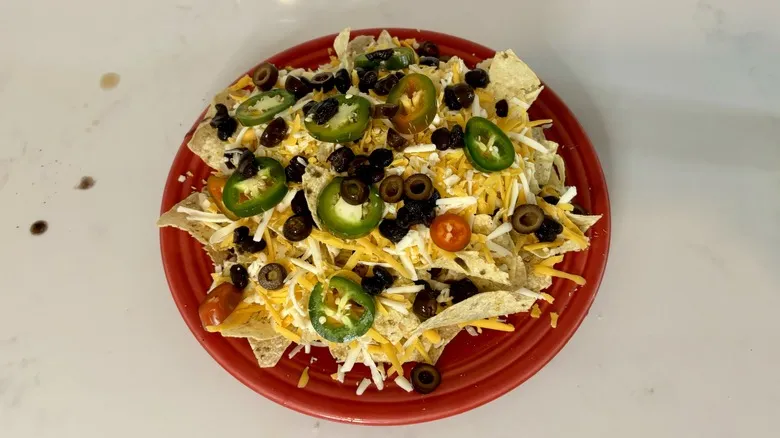
Once you grasp the fundamentals of making nachos, a world of flavor and texture possibilities unfolds. Your only limitation is your imagination. Ultimate chicken nachos are an excellent starting point, and these tasty sheet pan nachos are perfect for serving a crowd at a party or during a big game.
You’re not restricted to savory options, either. Think outside the box with dessert nachos featuring fudge sauce, ice cream, and homemade pita chips. There’s an entire universe of nacho creations waiting to be made, cooked, and savored, and now you’re all set to begin your culinary adventure.
Recommended

What Is Masago And How Do You Eat It?

How To Grill Shrimp Perfectly Every Time
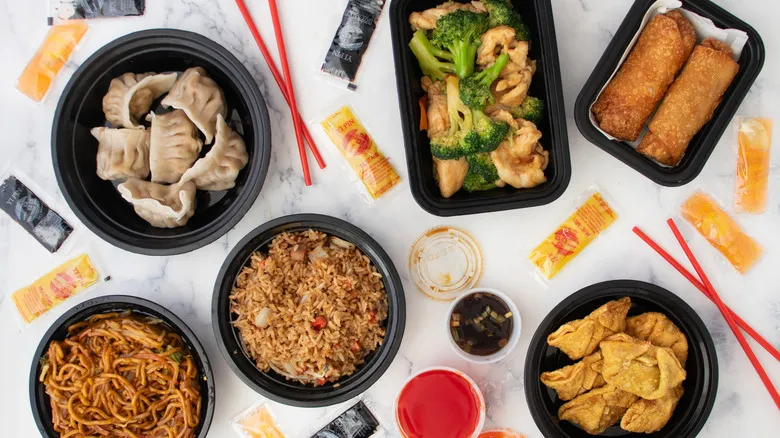
How To Reheat Chinese Food For First-Bite Flavor
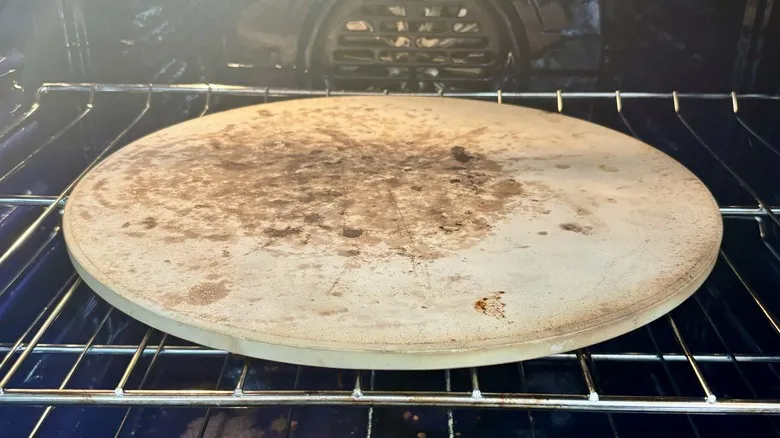
How To Clean Your Pizza Stone Without Ruining It
Next up

